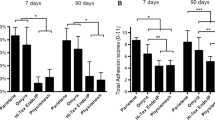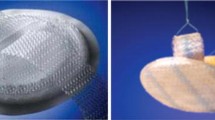Abstract
Background
Effective laparoscopic ventral herniorrhaphy mandates the use of an intraperitoneal mesh. Visceral adhesions and shrinkage of prosthetics may complicate repairs. The aim of this study was to compare adhesion formation, mesh shrinkage and tissue ingrowth after intra-abdominal placement of a novel two-component monofilament mesh structure made of polypropylene (PP) and polyvinylidenfluoride (PVDF) with current alternatives.
Materials and methods
Forty Sprague-Dawley rats were used in this study. Mesh samples were fixed as intra-abdominal only mesh at the right lateral abdominal wall. The study groups were: PVDF+PP (polypropylene parietally and polyvinylidenfluoride viscerally), PP+Col (polypropylene with a collagenoxidized film), ePTFE (smooth surface viscerally and a textured surface parietally), and PP (a pure polypropylene mesh serving as control). The meshes were explanted after 30 days. Adhesions were scored as a percentage of explanted biomaterials’ affected surface area; prosthetic shrinkage was calculated. Foreign-body reaction to mesh materials was measured by investigating the amount of inflammatory infiltrate and fibrotic tissue formation.
Results
In terms of adhesion score, the pure PP mesh showed the highest values followed by the ePTFE, PVDF+PP, and PP+Col meshes. Quantitative assessment of adhesion area revealed a significantly higher value of the pure PP mesh sample (62.0 ± 22.1%) compared with the PP+Col (26.8 ± 12.1%) and the PVDF+PP mesh (34.6 ± 8.2%). Percentage of shrinkage showed a significantly higher value of the ePTFE mesh (52.4 ± 13.9%) compared with all other mesh modifications (PP+Col 19.8 ± 13.9%, PVDF+PP 19.9 ± 7.0%, and PP 26.8 ± 9.5%). Inflammatory infiltrate was significantly reduced in the PVDF+PP mesh group compared with all other mesh samples.
Conclusion
The use of the novel two-component monofilament mesh structure made of polypropylene and polyvinylidenfluoride was found to be favorable regarding adhesion formation and mesh shrinkage compared to conventional mesh materials used for intra-abdominal placement.






Similar content being viewed by others
References
Rudmik LR, Schieman C, Dixon E, Debru E (2006) Laparoscopic incisional hernia repair: a review of the literature. Hernia 10(2):110–119
Fourtanier G, Muscari F, Duffas JP, Suc B (2006) Laparocopic repair of incisional hernias: a gold standard? Ann Chir 131(4):233–235
Kingsnorth A, LeBlanc K (2003) Hernias: inguinal and incisional. Lancet 362:1561–1571
LeBlanc K (2001) Laparoscopic treatment of ventral hernia. Surg Endosc 15(10):1242
LeBlanc KA (2005) Incisional hernia repair: laparoscopic techniques. World J Surg 29(8):1073–1079
Novitsky YW, Harrell AG, Cristiano JA, Paton BL, Norton HJ, Peindl RD et al (2007) Comparative evaluation of adhesion formation, strength of ingrowth, and textile properties of prosthetic meshes after long-term intra-abdominal implantation in a rabbit. J Surg Res 140(1):6–11
Jacob BP, Hogle NJ, Durak E, Kim T, Fowler DL (2007) Tissue ingrowth and bowel adhesion formation in an animal comparative study: polypropylene versus Proceed versus Parietex Composite. Surg Endosc 21(4):629–633
Urban E, King MW, Guidoin R, Laroche G, Marois Y, Martin L et al (1994) Why make monofilament sutures out of polyvinylidene fluoride? ASAIO J 40(2):145–156
Klinge U, Klosterhalfen B, Ottinger AP, Junge K, Schumpelick V (2002) PVDF as a new polymer for the construction of surgical meshes. Biomaterials 23(16):3487–3493
The Surgical Membrane Study Group (1992) Prophylaxis of pelvic sidewall adhesions with Gore-Tex surgical membrane: a multicenter clinical investigation. Fertil Steril 57(4):921–923
Eriksen JR, Gogenur I, Rosenberg J (2007) Choice of mesh for laparoscopic ventral hernia repair. Hernia 11(6):481–492
McGinty JJ, Hogle NJ, McCarthy H, Fowler DL (2005) A comparative study of adhesion formation and abdominal wall ingrowth after laparoscopic ventral hernia repair in a porcine model using multiple types of mesh. Surg Endosc 19(6):786–790
Schug-Pass C, Tamme C, Tannapfel A, Kockerling F (2006) A lightweight polypropylene mesh (TiMesh) for laparoscopic intraperitoneal repair of abdominal wall hernias: comparison of biocompatibility with the DualMesh in an experimental study using the porcine model. Surg Endosc 20(3):402–409
Fischer T, Ladurner R, Gangkofer A, Mussack T, Reiser M, Lienemann A (2007) Functional cine MRI of the abdomen for the assessment of implanted synthetic mesh in patients after incisional hernia repair: initial results. Eur Radiol 17(12):3123–3129
Mussack T, Fischer T, Ladurner R, Gangkofer A, Bensler S, Hallfeldt KK et al (2005) Cine magnetic resonance imaging vs high-resolution ultrasonography for detection of adhesions after laparoscopic and open incisional hernia repair: a matched pair pilot analysis. Surg Endosc 19(12):1538–1543
Urban E, King MW, Guidoin R, Laroche G, Marois Y, Martin L et al (1994) Why make monofilament sutures out of polyvinylidene fluoride? Asaio J 40(2):145–156
Laroche G, Marois Y, Guidoin R, King MW, Martin L, How T et al (1995) Polyvinylidene fluoride (PVDF) as a biomaterial: from polymeric raw material to monofilament vascular suture. J Biomed Mater Res 29(12):1525–1536
Bellon JM, Garcia-Carranza A, Jurado F, Garcia-Honduvilla N, Carrera-San Martin A, Bujan J (2001) Peritoneal regeneration after implant of a composite prosthesis in the abdominal wall. World J Surg 25(2):147–152
Conze J, Rosch R, Klinge U, Weiss C, Anurov M, Titkowa S et al (2004) Polypropylene in the intra-abdominal position: influence of pore size and surface area. Hernia 8(4):365–372
Burger JW, Halm JA, Wijsmuller AR, ten Raa S, Jeekel J (2006) Evaluation of new prosthetic meshes for ventral hernia repair. Surg Endosc 20(8):1320–1325
Johnson EK, Hoyt CH, Dinsmore RC (2004) Abdominal wall hernia repair: a long-term comparison of Sepramesh and Dualmesh in a rabbit hernia model. Am Surg 70(8):657–661
Harrell AG, Novitsky YW, Peindl RD, Cobb WS, Austin CE, Cristiano JA et al (2006) Prospective evaluation of adhesion formation and shrinkage of intra-abdominal prosthetics in a rabbit model. Am Surg 72(9):808–813
Conze J, Krones CJ, Schumpelick V, Klinge U (2007) Incisional hernia: challenge of re-operations after mesh repair. Langenbecks Arch Surg 392(4):453–457
Klinge U, Klosterhalfen B, Muller M, Ottinger AP, Schumpelick V (1998) Shrinking of polypropylene mesh in vivo: an experimental study in dogs. Eur J Surg 164(12):965–969
Author information
Authors and Affiliations
Corresponding author
Rights and permissions
About this article
Cite this article
Junge, K., Binnebösel, M., Rosch, R. et al. Adhesion formation of a polyvinylidenfluoride/polypropylene mesh for intra-abdominal placement in a rodent animal model. Surg Endosc 23, 327–333 (2009). https://doi.org/10.1007/s00464-008-9923-y
Received:
Accepted:
Published:
Issue Date:
DOI: https://doi.org/10.1007/s00464-008-9923-y




